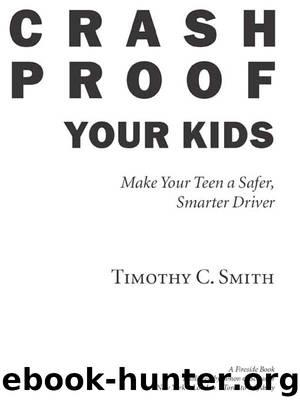Crash Proof Your Kids by Timothy C. Smith

Author:Timothy C. Smith
Language: eng
Format: epub
Publisher: Simon & Schuster
Published: 2006-07-15T00:00:00+00:00
Understanding the basics of vehicle balance isn’t that difficult. Here’s how to give your teen a firsthand feel for the principles involved:
Tell her that a car is essentially a heavy block of metal resting on springs that are attached to the tires,which in turn are connected to the road by four tiny patches of rubber.When the car is stopped, the weight of the block of metal is distributed pretty evenly on those springs and tires.
Find a safe stretch of road, and ask her to brake and pay attention to what happens to the mass of the car.Explain that when a car is in motion, braking causes the center of mass to move forward. She should feel forward movement and be pushed against the seat belt.At the same time, have her notice that the hood of the car drops and the rear of the vehicle rises.
Have her accelerate, and notice that doing so shifts the center of mass back to the rear. She will feel movement toward the rear and be pushed back in her seat. Now the hood rises and the rear drops, the opposite of braking.To help her remember these two fundamental aspects of balance and weight transfer, have her think about the movement of the front hood of the car, and remember this simple phrase: “Gas up, brake down.” (Note: Although the basic principles of balance and weight transfer discussed in this chapter apply for the most part to all types of vehicles, they most accurately apply to rear-wheel-drive vehicles. Front-wheel-drive cars act a little differently in some circumstances. For instance, because of the front-wheel traction and the additional weight up front from the drive-train, when you lift off the gas with a front-wheel-drive car, weight is typically transferred forward rather than backward.)
Find an intersection, and have her make a turn while braking, again concentrating on what happens to the mass of the car. She’ll notice that when steering is applied, the center of mass transfers to the right or left side of the vehicle. For example, steering right causes the right side to dip and the left side to rise. Stress that these weight transfers and body tilts all have an effect on traction, the ability of those four small patches of rubber to keep her on the road and in control.
Describe what typically gets teens in trouble on curves, where they run off the road and crash at far higher rates than older drivers. Let’s say they enter the curve from a straight stretch with a balanced car.What often happens is that they enter the curve at the same speed as the straightaway, which is too fast. Then they get midway through the turn and feel their tires slip, so they hit the brakes. Pretty reasonable response, right? Actually, no. The reason the tires started to slip is that the driver was asking them to do two things at once—maintain traction and change direction—at a speed where it was impossible to accomplish both.What happened with the
Download
This site does not store any files on its server. We only index and link to content provided by other sites. Please contact the content providers to delete copyright contents if any and email us, we'll remove relevant links or contents immediately.
| Administration | Assessment |
| Educational Psychology | Experimental Methods |
| History | Language Experience Approach |
| Philosophy & Social Aspects | Reform & Policy |
| Research |
The Art of Coaching Workbook by Elena Aguilar(51080)
Trainspotting by Irvine Welsh(21572)
Twilight of the Idols With the Antichrist and Ecce Homo by Friedrich Nietzsche(18570)
Fangirl by Rainbow Rowell(9177)
Periodization Training for Sports by Tudor Bompa(8213)
Change Your Questions, Change Your Life by Marilee Adams(7686)
This Is How You Lose Her by Junot Diaz(6835)
Asking the Right Questions: A Guide to Critical Thinking by M. Neil Browne & Stuart M. Keeley(5709)
Grit by Angela Duckworth(5556)
Red Sparrow by Jason Matthews(5427)
Paper Towns by Green John(5139)
Room 212 by Kate Stewart(5072)
Ken Follett - World without end by Ken Follett(4684)
Housekeeping by Marilynne Robinson(4394)
The Sports Rules Book by Human Kinetics(4344)
Double Down (Diary of a Wimpy Kid Book 11) by Jeff Kinney(4242)
Papillon (English) by Henri Charrière(4228)
The Motorcycle Diaries by Ernesto Che Guevara(4052)
Exercise Technique Manual for Resistance Training by National Strength & Conditioning Association(4023)
